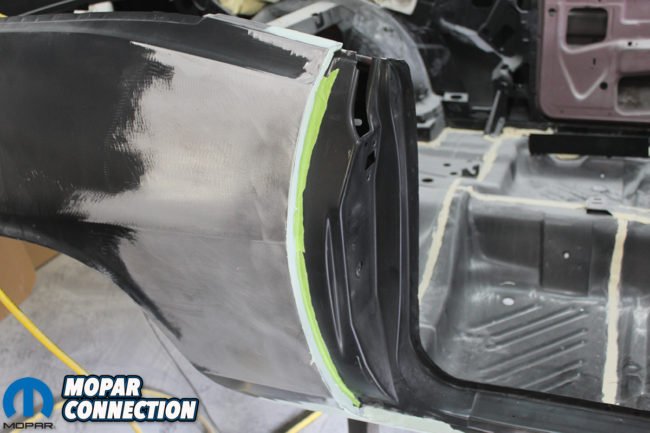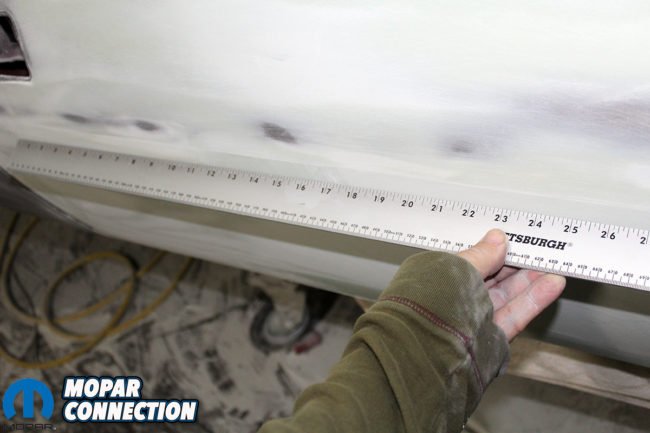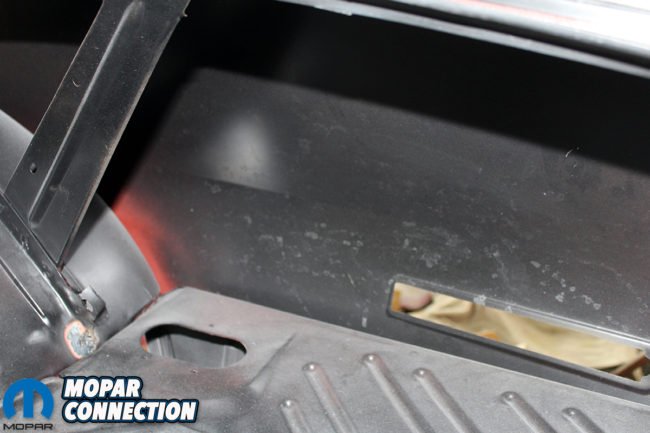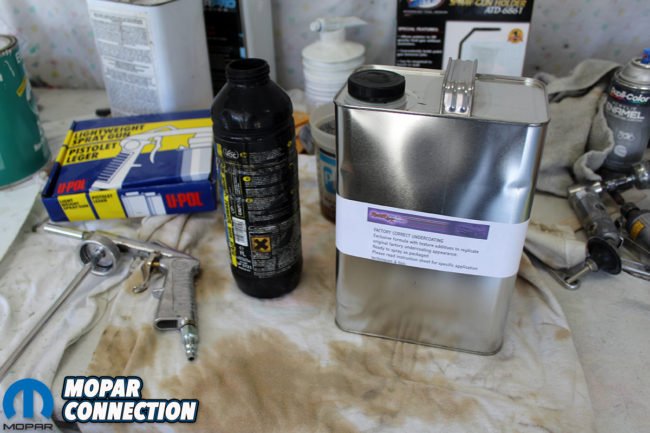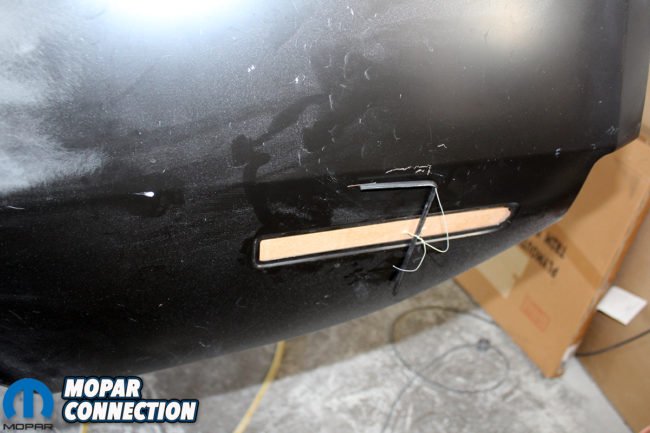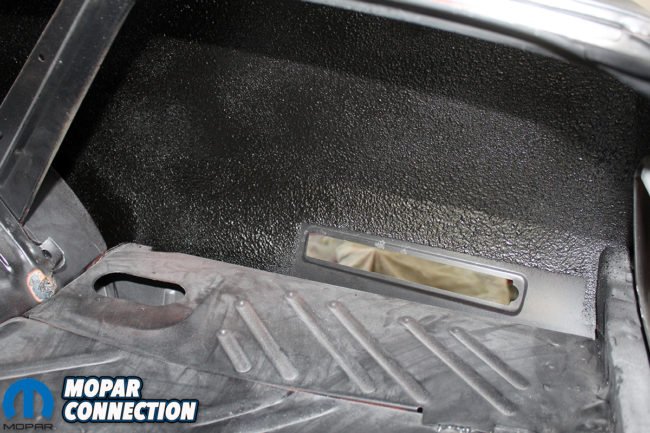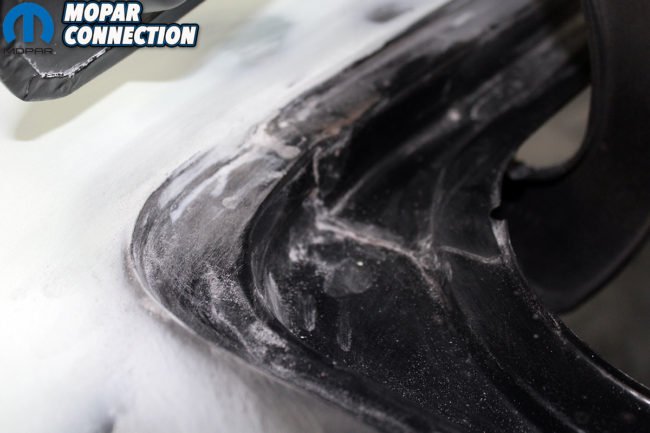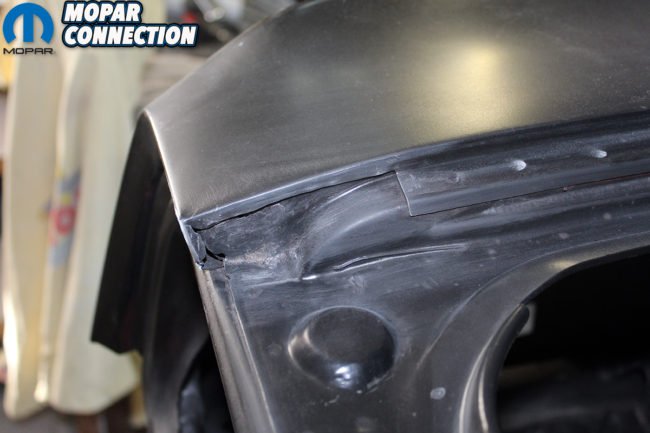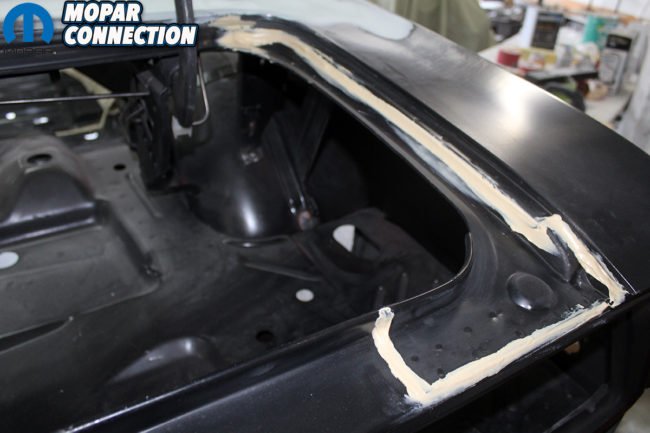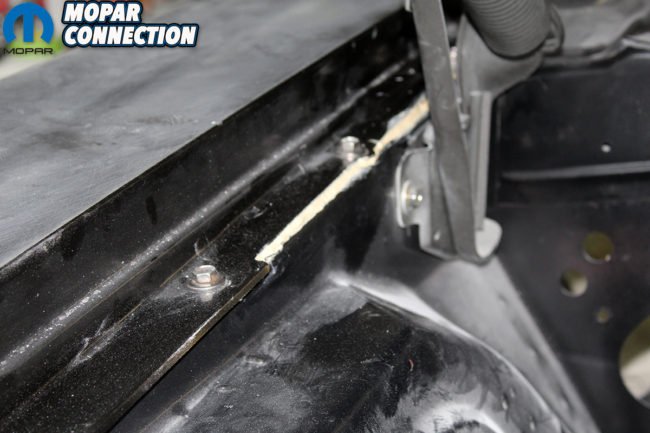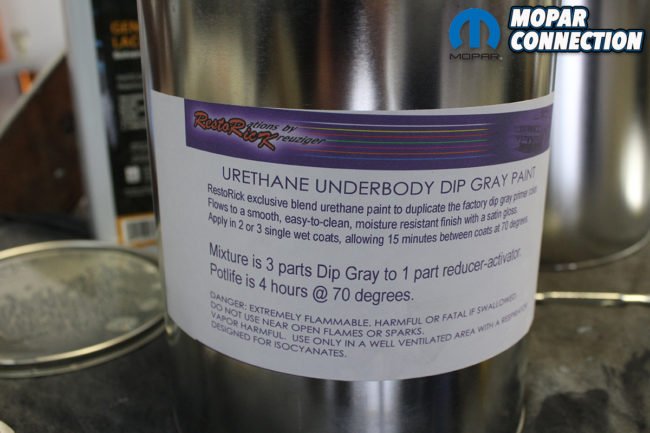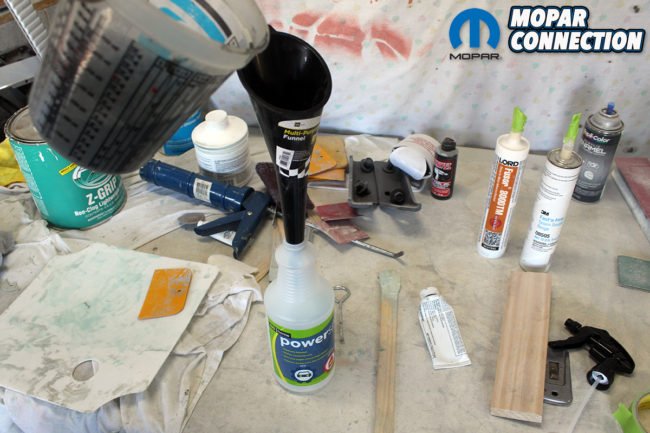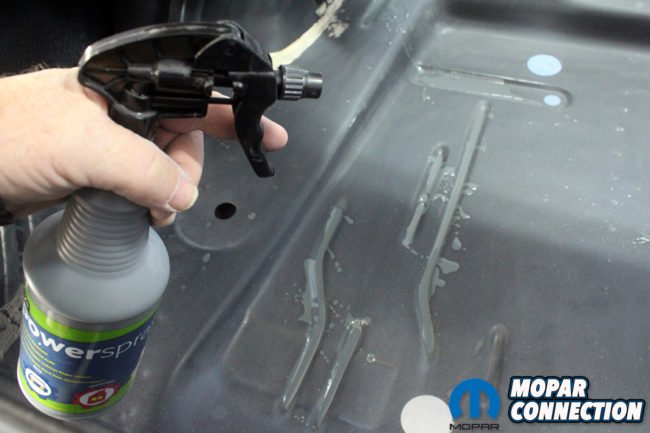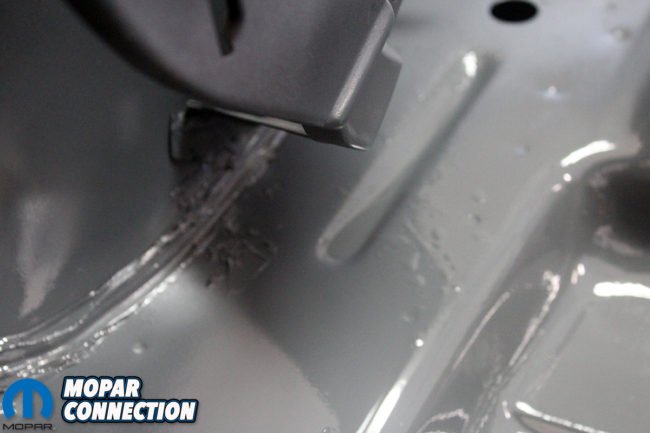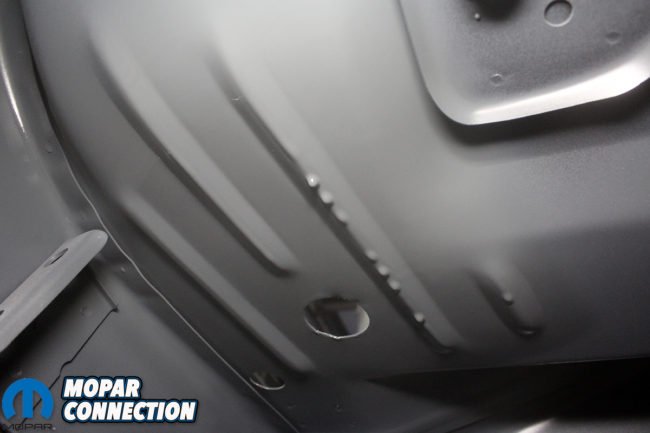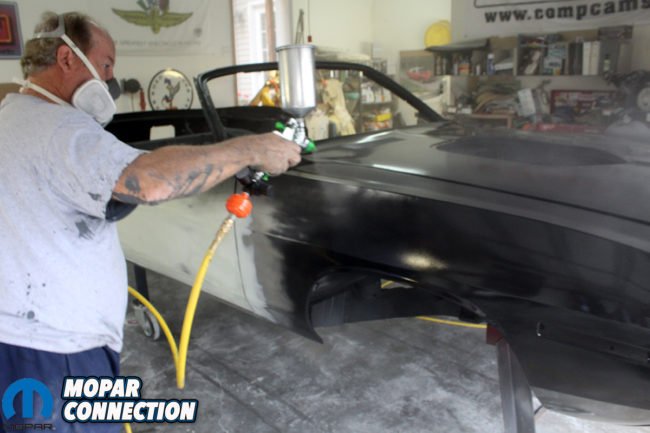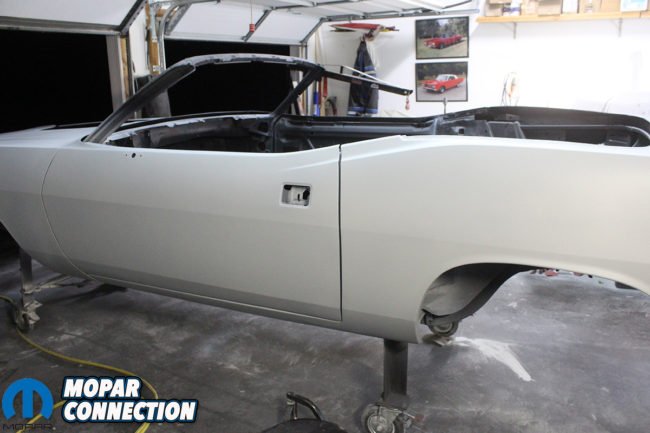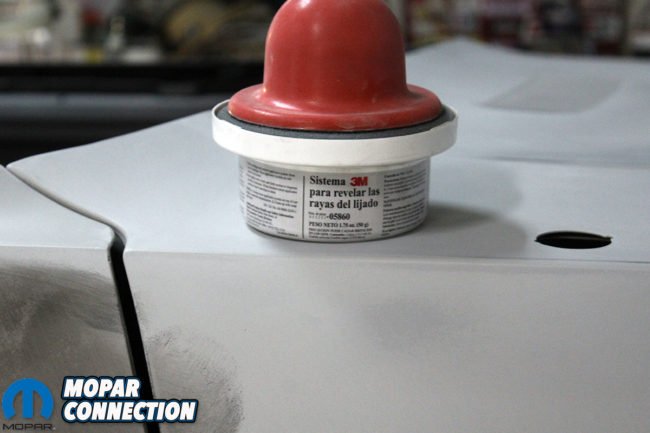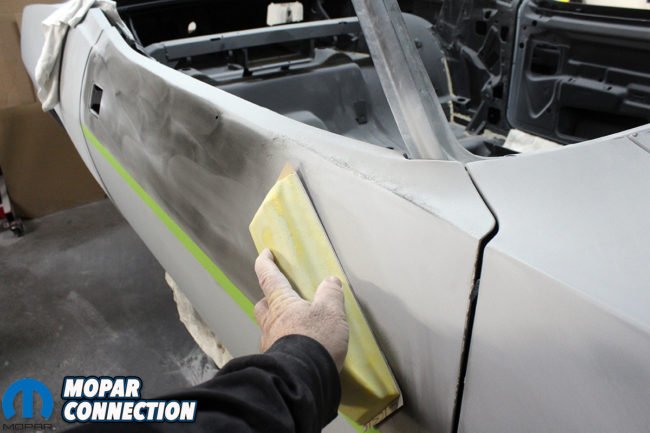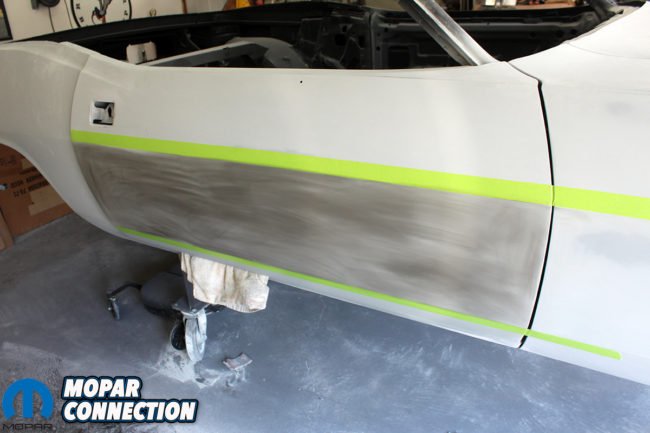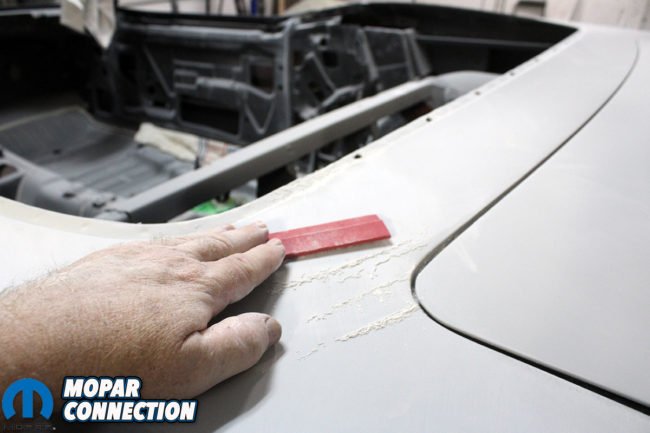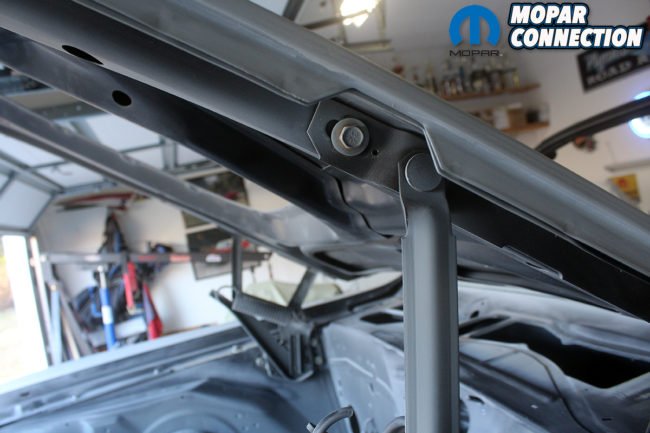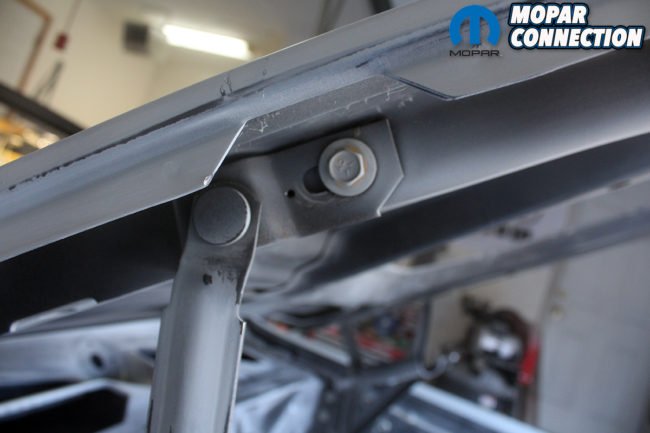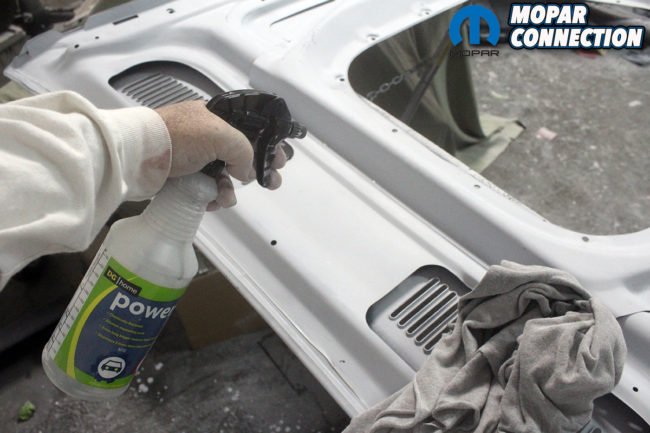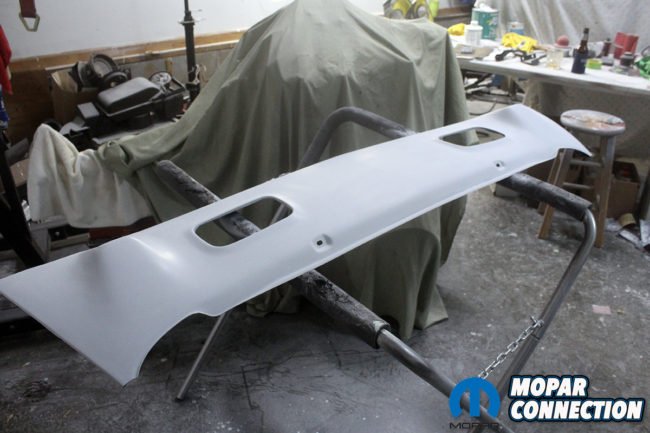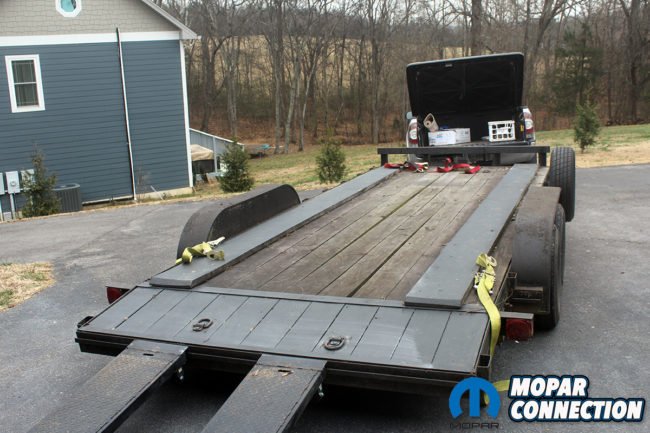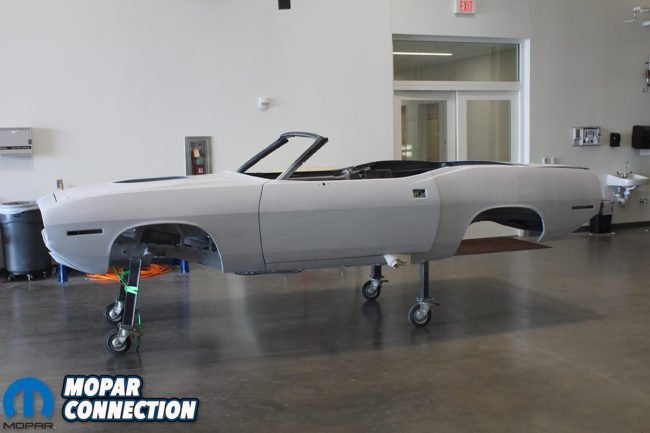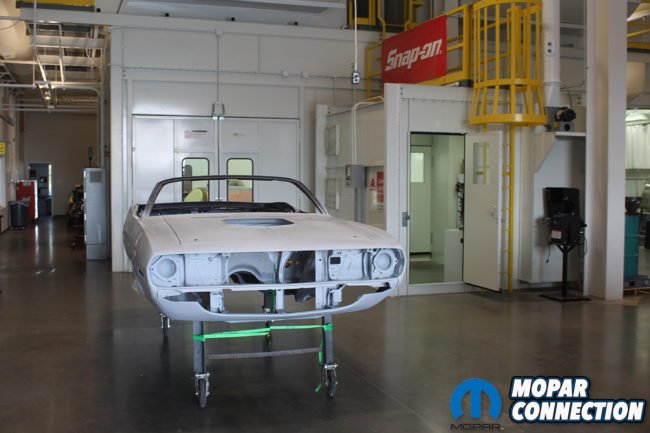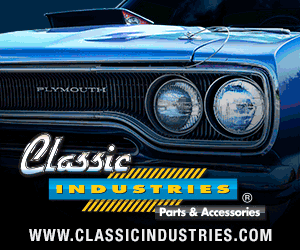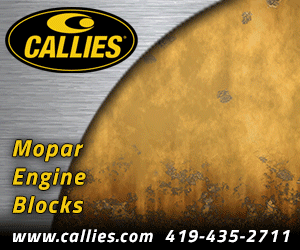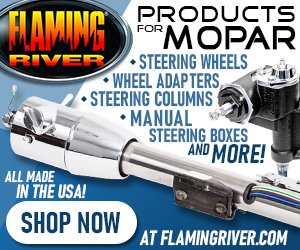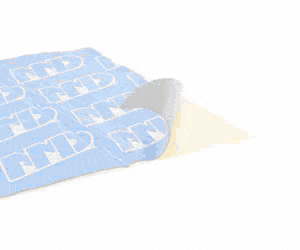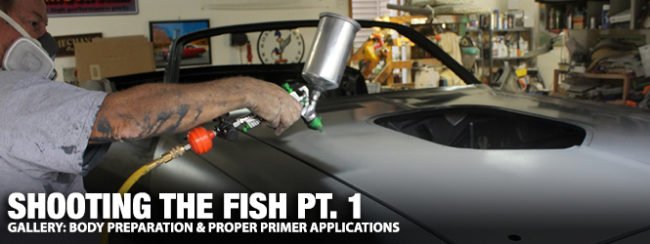
With all of the body work complete, it was time to get Mopar Connection’s longterm Comeback ‘Cuda project ready so we could shoot color. Since we were starting with basically a brand new body, we had to take specific steps to get it in the condition just like the factory did before the color went on. That included taking the fenders back off and applying seam sealer between the fenders and the inner fender wells, and applying sound deadener to the inside of the quarter panels. Then, we needed to apply seam sealer to the front and rear raw seams, trunk lid, hood, and shoot the factory dip primer. Next, we shot black epoxy primer, grey high-build primer, sanded, and then shot light grey 2K primer, sanded again, and then we had to get it to the paint booth. The single most important step to any restoration is paint and the most important part of paint is preparation. But we’re getting ahead of ourselves, so let’s back up:
The spot welds made at The AMD Installation Center are pretty deep. Don’t get us wrong, we like that fact! But to mimic the factory seams they need to be dressed with some filler. We were careful not to fill them completely, as we still needed to see them to look original we also needed some filler in the lower rocker seam (keeping it somewhat sloppy to keep the factory correct finish). Next, we checked the doors with a straight edge, and all other panels to make sure all was well before proceeding. The wheel well spot welds were also dressed.
Above left: We like to “dress” the spot welds with some filler. Some restorations will completely fill the welds. We chose to leave just a small indention to create a nice finish, similar to the factory original. We used tape to make sure that the clean edge of the quarter panel where it meets the door jam is preserved. You can also see where we sanded off the e-coat down to the bare metal. Above right: With an extra long, metal straight edge, we re-checked the doors to make sure they were level and straight. We made sure all of the body work was perfect. After shooting the primer is not a good time to have to make changes.
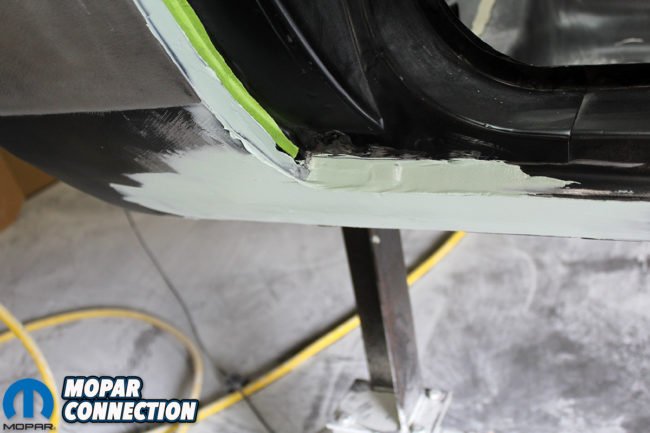
Above: We already leaded the rocker-to-quarter panel seam. We skim coated it with “short strand fiberglass” filler. We now finished the corner with body filler. It was applied messy from the factory originally. We will smooth and finish this area to better than factory.
Above left: Here you can see the new sheet metal in the trunk. There isn’t any seam sealer where the trunk and the wheel wells meet. There isn’t any sound deadener on the quarter panels either. We had to scuff and sand any area that needed seam sealer as well as prepare the entire trunk for primer. The guys at AMD Installation and Classic Muscle Metal really did a fantastic job getting the Comeback ‘Cuda back to a brand, new car. Above right: The undercoating from Resto Rick is the best we have found. We used it not only in the wheel wells but inside the doors and on the inside of the quarter panels as sound deadener. There are several different brands of undercoating guns out there. All work about the same but we always drill out the nozzle, so it will shoot the undercoating in a heavy enough spray.
The factory shot sound deadender on the inside of the quarter panels before they were welded to the body. There isn’t any deadener on the Comeback ‘Cuda’s new metal. We used the undercoating from “Resto Rick’s” and a shutz gun with the nozzle drilled out so it will go on heavier. We also shot the inside of the doors (that had been blasted) to seal them. We cut cardboard pieces that matched the original quarters’ sound deadener imprint and used some wire to hold the cardboard in place.
After shooting the undercoating and removing the masking pieces we got a factory-correct appearance. Here’s a tip: do the trunk before painting and the wheel wells are shot after paint. The wheel well undercoating accomplishes two things: First, it protects the fenders from rock chips from the tires showing up on the tops of the fenders. Secondly, it just looks better. There’s nothing worse than seeing a bright paint color behind the tire. Ma Mopar never did it that way!
Above left: We took a pattern of the area that was masked off on the original quarter panel before they were removed. We cut some cardboard from the pattern and put some fine wire through the cardboard. Above center: We then positioned the cardboard inside of the trunk and secure it with any kind of a rod so that it won’t move while spraying. Here we used a large Allen wrench to hold the mask. We tried to get the undercoating as far back behind the wheel well as possible. The original sound deadener was applied to the quarter before it was even welded together, therefore, masked off the trunk floor and wheel wells to remain correct. Above right: This E-body’s original undercoating was relatively thin and surprisingly even. We have seen B-bodies that have tons of undercoating applied in heavy and thin irregular patterns. We just tried to replicate what our car originally had.
Above left: One of the raw seams that was going to need sealer is where the quarter panel meets the Dutchman panel. On a hardtop this seam only gets a small bead. On a convertible the seam is filled and finished smooth on the exposed part of the Dutchman panel. On a hardtop you can still see the divider line on top of the quarter. Using the original seam as a guide we reproduced the sealer. Yes it is not sanded out but is left natural with the look of it being wiped. Above right: From the Dutchman panel there is a seam that runs between the quarter panel and the trunk lip channel. This seam continues all the way to the lower edge of the channel. As you can see there is also a raw seam where the quarter meets the rear panel.
Above left: Again, a bead of sealer was applied and wiped along the entire length of the seam. Using the original seam as a guide we reproduced what we found from the factory. After the sealer dried we came back and smoothed the edges with some 220-grit sand paper to knock off any high spots or sharp edges. Above center: In the front where the fender meets the inner fender we applied sealer between the two with additional sealer extending across the top of the fender and all along the seam to the front where the fender meets the radiator support. Above right: Where the sealer is applied between the outer and inner fender often where the bolts are tightened some of the sealer “squeezes” out. This was wiped leaving the evidence that sealer was applied. Many, many restorations, skip this step leaving these seams void of any sealer. That’s not the way the factory did it and it is easy to spot. This sealer between the inner and outer fenders was present in all B, E, and C-bodies of this era. That’s why you must paint the car with the fenders in place to be original.
There are several raw seams in the front, rear, trunk lid, and hood. There was also sealer between the outer and inner fenders from the factory. Many restorations chose not to do this, but we knew we’d never be here again, so we needed to do it the way the factory did. We removed the fenders, applied the sealer and wiped off the excess. The front of the fenders also got sealer and it was applied messily. In the rear, we also had to seal the Dutchman panel to the quarter panel. We have seen either a very small amount or a lot of sealer.
Since this car is a convertible, it would have more sealer in these joints than a hardtop. We correctly reapplied the sealer the way we found it. Also, the quarter-to-the-trunk lip and rear panel needed to be sealed. We found sealer on the original trunk lid only on the sides and underneath the rear lip seam. There wasn’t any on the seam where the trunk lid meets the Dutchman panel. So, we reapplied it as we found it. Also, the hood rear seam was sealed. After applying all the factory sealer we moved on the next step shooting the dip primer.
Above left: Now that all the seams have been sealed it was time to shoot the “dip primer”. Before Resto Rick came out with his “dip primer,” we used to mix DP epoxy grey primer with DP black primer to get the desired color of the factory “dip primer”. Even though it was epoxy, we still painted over it with a satin clear to make sure we had a good seal against moisture. With the dip primer from Resto Rick, it simplifies and improves the results. It is a urethane two-part paint that seals and protects in one step. If you want the factory overspray look but want to drive the car in all types of weather on a daily basis, we recommend still top coating it with clear. But for most of our cars that isn’t needed. Above right: When you buy the dip primer from Resto Rick it comes with the primer and the “reducer-activator” complete and ready to mix and shoot. We shot the entire undercarriage making sure to cover all the floor pan and braces completely all the way to the pinch weld of the car. We used a primer gun with a 2.5 mm tip for a good heavy coat of primer.
Above left: Before we painted the trunk and interior floor boards we took the reduced-activated primer and poored it into a spray bottle. Above right: We then took the spray bottle and filled all the concave ribs in the trunk and interior. This will recreate the extra paint that remained after the car was dipped at the factory and the excess drained off through the holes in the pans.
Above left: We then shot the trunk and floors with the gun making sure to shoot it heavy. That way there was plenty of paint left in the ribs. We masked off the firewall to recreate the dip line about halfway up the firewall and along the doors on the inside. No need to paint the outside even though when dipped at the factory there was paint there that was wiped off before the regular primer was applied. Above center: We then took the front and rear valances and shot them with the dip primer only on the back sides. When you shoot them with the following layers of primer and color you will get the same over spray patterns that occurred naturally with the factory process. Above right: After the correct flash time of 15 minutes we re-shot the undercarriage with a second heavy coat intentionally applying enough dip primer to recreate the factory drips. When we judged the OE Class at the Mopar Nats this past year, we had an unrestored Superbird entered in the class. These drips were in fact present on every rib and some even around the drain holes.
The original dip primer from the factory was water based. The holes in the floor allowed the primer to run out after it was dipped. So, the rough, crinkled paint found on original cars in the ribs is hard to replicate. The undercarriage drips are much easier to reproduce. We used the dip primer from Resto Rick. It protects and replicates the factory dark grey dip primer better than any product we have found. We shot the undercarriage and the floors half way up the firewall. Next, we took a spray bottle filled with primer and over-filled the ribs. The undercarriage drips are easy. Just shoot the primer heavy. We also removed the front and rear valance and shot dip primer on the back sides of those panels.
After sanding the entire car and engine compartment with 80 grit, we shot everything with two coats of black epoxy primer from PPG. After that, we shot the car with two heavy coats of high build, sandable primer. The epoxy primer does not sand well at all. The high-build primer is great for getting the body straight. We like to use the dry guide coat and level the panels with 180 grit sand paper, using various size sanding blocks.
Above left: After sanding the entire car with 180 grit we laid on two coats of black epoxy primer. We didn’t need to shoot the areas that have the dip primer with more epoxy. We used the primer gun with large capacity cup and a 2.5 mm tip. Above center: This stuff from PPG really goes on and lays down great! Above right: After letting the epoxy dry the correct amount of time listed on the P sheet, we shot two heavy layers of high build sandable primer. It is light gray. By using a different color primer any places that get sanded through will show up.
Above left: For the first time since the original incident, the car is together and in one color. Man, does the Comeback ‘Cuda look great! About now, the adrenaline really gets flowing. That’s a good thing because we are facing hours and hours of block sanding to get this ‘Cuda ready for color. Above right: We like to use the dry guide coat made by 3m. Some people just shoot a light coat of black primer as a guide coat. To us, the dry goes on better and gives immediate feedback on the effectiveness of your block sanding. Plus, you don’t have to smell the paint fumes without a mask.
Above left: First, we taped off the upper body line on the door. Since the doors for these cars are not reproduced, we had had to put a lot of time getting these doors straight. The tape helped us continue to keep the body lines crisp and correct. Always use automotive quality tape and not the cheap stuff. The green 3m tape works well and doesn’t leave any adhesive residue. Then we rubbed on a good coat of the dry guide coat. Above center: We used 220-grit sandpaper that comes in a roll and has adhesive on the back on a 12-inch block, being sure to use a crosshatch pattern while sanding to insure a flatter more uniform surface. The high build primer sands like a dream. Always pay extra attention on all edges and since we already have the car assembled and all the gaps and lines set the way we want them you can sand across the gaps like between the door and fender to create a smooth and even transition. Above right: After the top panel was sanded we removed the tape and re-taped the other side of the body line. Then we taped the lower body line, applied the dry guide coat and repeated the process on every body panel of the car.
From this point forward, we always taped the body lines. This is an important step so that when the car is finally painted the lines are straight and crisp. After spreading the dry guide coat, we sanded the area with an 8-inch foam block. Then after sanding the upper body panel, we taped the middle lines and repeated the process. Each side panel is carefully sanded using the tape for the body lines, the guide coat, and the 180-grit block. We used the 180 self stick rolls of sand paper. In the smaller areas, a paint stick wrapped with sand paper works well with great results.
After all of the panels were sanded and straight, we shot 2K primer over the entire body including the engine compartment and trunk. There wasn’t any reason to shoot the high build primer in the trunk and engine compartments, since both areas were brand new metal. We did sand all the e-coat in these areas with 180-grit followed by two coats of 2K primer. We did wet sand the 2K primer with 400 later. This did not leave visible sanding scratches, since we shot the entire car with PPG sealer when we got it in the booth, filling any 400 grit sanding scratches that might’ve been left.
Above left: We always use some type of block while sanding the high build primer. Here we used a paint stick wrapped in the 220-grit paper. Just using your hand and not some kind of block you will get what we call “finger tracks”. They will show up after color is applied. You should not only use the crosshatch pattern in sanding but be sure and sand toward the edges. That will give you a true straight edge. Above right: After sanding all the panels with 220-grit and guide coat, we wiped the car down and got all the sanding dust off the car (and out of the garage). We then shot everything with two good coats of 2K primer. The high build is for getting everything straight and the 2K will fill the 220 sanding scratches. We then wet sanded all the 2K with 400-grit paper. This will was our final surface before color so we careful to take our time, watching the edges, and using plenty of soapy water in our spray bottle as we sanded.
Above left: After getting the 2K primer wet sanded we then blew apart the car. We removed the hood, the truck lid, the upper grille surround, and the lower grille surround. Since we had everything lined up and gapped correctly, we used an 1/8-inch drill bit and drilled some pilot holes on the hinges. This way re-assembly will be exactly where we had it. Above right: We drilled both sides of the hood hinge. One by the front bolt and another by the rear bolt. After paint and reassembly we simply fill the hole with silicone and touch that up with paint.
Above left: With the hood and deck lid off the car we wet sanded their undersides. We also re-shot the areas that missed primer where the panels were mated. Above center: There are so many ridges and valleys on the underside of the hood that having it on the folding workstand made the wet sanding much easier. Again, we were using 400-grit paper and a spray bottle with water and a few drops of dish soap. Above right: With the car apart we got some very good work done on each of these separate pieces. Here the rear valance was wet sanded on the workstand. Remember the backside of the valance is finished in dip primer. The exterior of the panel is 2K primer. After all the disassembled parts were sanded we re-assembled the Comeback ‘Cuda using the pilot holes and got the car ready to transport to the paint booth.
Having done several restorations over the years, we like to drill pilot holes in the hood, and truck hinge braces that we later use a nail to help align the hinges and panels. This way reassembly is easy. The last thing we want to do is tighten up the bolts, mar the paint, and have to make several adjustments. This procedure insures that everything returns to the position, where they were pre-fit. After paint, we seal the hole with silicone and touch up with body color. So, we have removed the hood, trunk lid, front and rear lower valances, front upper grille surround and lower grille surround. We shot the backsides and edges of all those parts, and wet sanded them before we re-assembled everything back on the car for transportation to the paint booth.
We made an appointment to use the facility where the dual spray booth is located. Because of our deadline, we had to work pretty much non-stop to get the body ready for paint. The final day came when we needed to deliver the car, and wouldn’t you know it, the weather turned brutally cold. After getting several friends lined up to help us load the car, we began the process of getting the Comeback ‘Cuda to the paint booth. Carefully planning out each step of the loading process ensured a successful transition without any problems.
Above left: The car was on pedestal stands with smaller wheels. This created several challenges in getting the car to the paint booth. We took the ramps and welded some flat steel panels, so the car would roll onto the trailer. With the help of several Mopar buddies were rolled the car from the garage onto the trailer. Above left: After getting the car on the trailer it took several straps to secure it. We crisscrossed the straps to keep the car more stable. With car so far up in the trailer it was imperative to keep it stable during transportation. The doors, trunk lid, and hood were padded and secured with smaller straps so they wouldn’t get damaged.
Above left: After getting the straps secured we took several short 2×4’s and a screw gun and boxed in the wheels. We did this because the casters are on swivels and we didn’t want them to shift during transportation and cause slack in the straps. We had to take the Interstate for about an hour to get to the booth and we needed the car to remain secure at 60-plus-miles per hour. Above right: Even though we brought the Comeback ‘Cuda home to Nashville from AMD Installation in Georgia using the same equipment, there is something nerve-racking about towing a car so far up in the air.
Above left: All went as planned without any problems. When we got to the facility where we would be painting the car several of the students were available to help us unload. Most of them were under 25 years of age and had never seen a convertible ‘Cuda in person. It was fun telling them about it. Above right: The computer controlled, heated and air conditioned, down draft, double booth was beyond state of the art. The excitement of being able to finally shoot the car the next day was unbelievable. Many, many hours of work during the year to get it here.
Lining up a booth is an important part of getting the car in color. Everything up to this point was done in a standard two-car garage with an additional work area. Sometimes you can rent a booth from a local body shop for a weekend. Sometimes you can work with a local tech school and even get them to shoot the paint for you. We were fortunate enough to hook up with a tech school facility over Christmas break. This booth was a state-of-the-art down draft booth complete with heat, air, and a bake cycle to help cure the paint. We have been restoring cars for over 40 years, and this facility is the best we have ever seen! And as this is just the first part of “Shooting the Fish”, Part 2 will include final prep before paint, shooting the color, re-assembly, and getting the Comeback ‘Cuda home for wet sanding, and buffing, and the final result.



